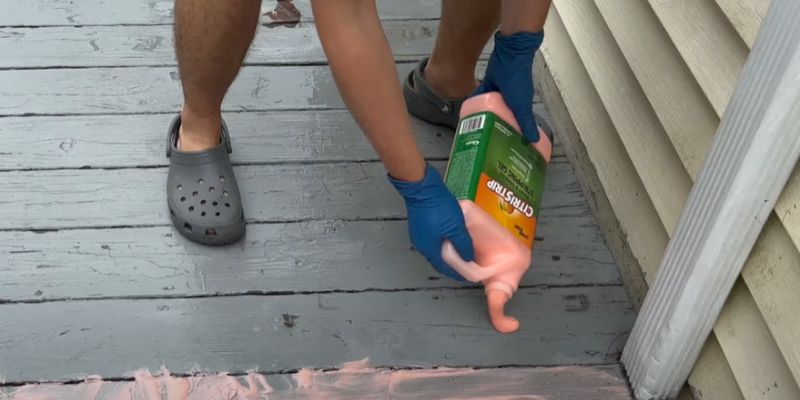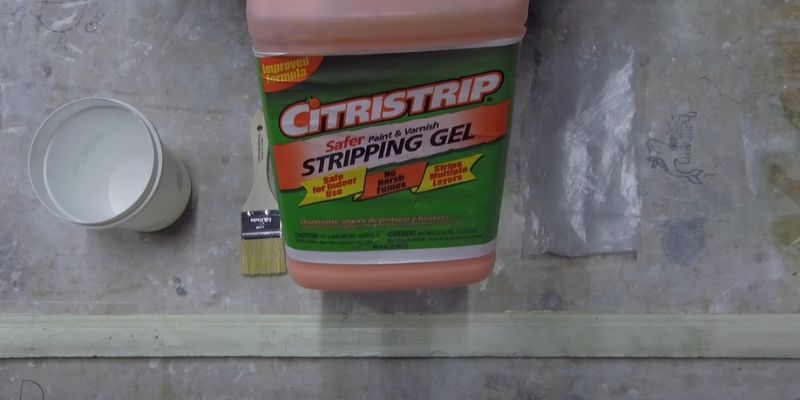Yes, Citristrip can be used on plastic surfaces. Using Citristrip is a safe and effective way to remove paint and varnish from plastic items without causing damage or discoloration.
By following the instructions provided, you can effectively strip paint from plastic surfaces and achieve a clean, smooth finish. Whether you have plastic furniture, toys, or other plastic items that need refinishing, Citristrip can be a reliable solution. Its unique formula is safe for use on various materials, making it a versatile option for paint removal projects.
Say goodbye to unwanted paint on plastic with the help of Citristrip.
Understanding Citristrip
Citristrip is a powerful and popular stripping agent that is commonly used to remove paint and varnish from various surfaces. What sets Citristrip apart from traditional paint strippers is its unique composition and non-toxic nature. This makes it a safer option for both the user and the environment. Many people wonder if Citristrip can be used on plastic surfaces. In this article, we will explore the composition of Citristrip and how it works, shedding light on its suitability for plastic surfaces.
Composition Of Citristrip
The composition of Citristrip is what makes it stand out among other paint strippers. One of the key ingredients in Citristrip is d-limonene, which is derived from citrus fruits. D-limonene is responsible for the pleasant citrus scent of Citristrip, making it more user-friendly compared to the strong and harsh odors associated with traditional paint strippers.
Additionally, Citristrip contains a blend of surfactants, emulsifiers, and solvents that work together to effectively break down the chemical bonds in paint or varnish. The unique combination of these ingredients results in a potent stripping agent that is safe to use on a variety of surfaces, including wood, metal, and even some plastics.

How Citristrip Works
Citristrip relies on a chemical reaction to effectively remove paint or varnish from surfaces. When the Citristrip is applied to a surface, the d-limonene and other active ingredients penetrate the layers of paint or varnish, breaking down their chemical composition. This process weakens the bond between the paint or varnish and the surface, allowing for easy removal.
Once the Citristrip has been applied, it is recommended to cover the surface with plastic wrap or a plastic bag to prevent the product from drying out too quickly. The longer the Citristrip remains in contact with the paint or varnish, the more effective it will be at stripping the unwanted coating.
After an appropriate amount of time, usually around 30 minutes to several hours, the softened paint or varnish can be easily scraped off with a plastic scraper or putty knife. It is important to note that while Citristrip may be effective on some types of plastic, it may not work as well on all plastic surfaces. It is always recommended to test Citristrip on a small, inconspicuous area of the plastic before applying it to the entire surface.
Using Citristrip On Plastic
When it comes to removing paint or varnish from plastic surfaces, many people wonder if they can use Citristrip. As a powerful paint stripper known for being effective on various materials, it’s natural to consider whether it can be safely used on plastic. In this article, we will explore the process of using Citristrip on plastic and discuss the necessary preparations, application techniques, and safety precautions to ensure successful results.
Preparation
Before applying Citristrip to plastic, it is essential to properly prepare the surface to ensure the best outcome. Follow these steps to prepare the plastic for paint or varnish removal:
- Clean the surface: Begin by cleaning the plastic surface with a mild detergent and warm water. This will remove any dirt, dust, or grease that may interfere with the stripping process.
- Test a small area: Before applying Citristrip on the entire plastic surface, test it on a small, inconspicuous area. This will help determine the stripping time needed and ensure that it does not cause any damage or discoloration.
- Protect surrounding areas: Cover any adjacent surfaces or areas that do not require paint or varnish removal with plastic sheets or newspapers. This will prevent accidental contact and potential damage to those surfaces.
- Wear protective gear: It is crucial to protect yourself during the stripping process. Wear chemical-resistant gloves, safety goggles, and a mask to prevent any potential skin, eye, or respiratory irritation.
Application
Once the plastic surface is properly prepared, it’s time to apply Citristrip for effective paint or varnish removal:
- Apply a thick layer: Using a brush or a paint scraper, apply a thick and even layer of Citristrip onto the plastic surface. Ensure that the entire area is well covered, without leaving any patches or gaps.
- Cover and wait: After applying Citristrip, cover the treated plastic surface with plastic wrap or a plastic sheet to prevent the stripper from drying out quickly. Allow it to sit for the recommended time mentioned on the product label.
- Scrape off the residue: Once the recommended time has passed, use a paint scraper or a plastic spatula to gently scrape off the softened paint or varnish from the plastic surface. Work in small sections, applying light pressure to avoid damaging the plastic.
- Clean the surface: After removing the paint or varnish, clean the plastic surface with water and a mild detergent to remove any remaining residue. Rinse thoroughly and pat dry with a clean cloth.
Safety Precautions
When using Citristrip on plastic, it’s crucial to take the necessary safety precautions to protect yourself and the surrounding environment:
- Work in a well-ventilated area or use a protective mask to prevent inhaling any fumes emitted by the paint stripper.
- Avoid direct contact with the skin by wearing chemical-resistant gloves and protective clothing.
- Store Citristrip in a cool, dry place, away from direct sunlight and heat sources.
- Dispose of Citristrip residue and other materials used in a responsible manner, following local disposal regulations.
Using Citristrip on plastic can be an effective method for removing paint or varnish, as long as the necessary preparations are made, proper application techniques are employed, and adequate safety precautions are taken. By following these guidelines, you can achieve successful results while protecting both yourself and the plastic surface.

Alternatives To Citristrip For Plastic
Citristrip is a popular paint stripping agent known for its effectiveness on various surfaces. However, when it comes to stripping paint from plastic, it’s important to consider alternatives that are safe and won’t harm the material. In this post, we will explore some alternative options to Citristrip specifically for plastic surfaces.
Other Safe Stripping Agents
While Citristrip may not be suitable for plastic, there are other stripping agents that are safe and effective for this material. These alternatives work by breaking down the paint without causing damage to the plastic. Here are a few options to consider:
| Alternative | Description |
|---|---|
| Isopropyl Alcohol | Isopropyl alcohol, also known as rubbing alcohol, can be used to remove paint from plastic surfaces. It is effective in breaking down the paint without causing any damage to the plastic. Simply apply the alcohol to a cloth or sponge and gently rub the painted area until the paint starts to dissolve. |
| Acetone | Acetone is another option for stripping paint from plastic. It is a powerful solvent that can effectively remove paint without harming the plastic. However, acetone can be harsh on the skin, so it is important to wear gloves and work in a well-ventilated area. |
| Nail Polish Remover | Nail polish remover contains acetone, which makes it a useful alternative for removing paint from plastic surfaces. It works in a similar way to acetone and can effectively break down the paint. Remember to choose a nail polish remover that is acetone-based for best results. |
Mechanical Methods
If you prefer to avoid using chemicals, there are several mechanical methods you can try to remove paint from plastic surfaces. These methods involve physically scraping or sanding the paint away. Here are a few options:
- Sandpaper: Using fine-grit sandpaper, gently sand the painted area in a circular motion until the paint starts to come off. Be careful not to apply too much pressure to avoid scratching the plastic surface.
- Plastic Scraper: A plastic scraper or putty knife can be used to carefully scrape away the paint from the plastic surface. This method is particularly useful for removing thick layers of paint.
- Heat Gun: Applying heat to the painted area using a heat gun can help soften the paint and make it easier to scrape off. Be cautious and keep the heat gun at a safe distance to avoid any damage to the plastic.
When using mechanical methods, it’s essential to work slowly and gently to avoid damaging the plastic. Test a small, inconspicuous area first to ensure the method you choose doesn’t harm or melt the plastic.
By considering these alternative options to Citristrip, you can safely and effectively remove paint from plastic surfaces. Remember to read and follow the instructions provided by the manufacturer of the stripping agent or tool you choose, and always take necessary safety precautions.
Frequently Asked Questions On Can You Use Citristrip On Plastic
Can I Use Citristrip On Plastic?
Yes, Citristrip can be used on plastic surfaces. However, it is important to follow the instructions carefully and perform a patch test first to ensure it doesn’t damage or discolor the plastic. Avoid leaving Citristrip on plastic for extended periods of time.
Is Citristrip Safe For All Types Of Plastic?
Citristrip is generally safe for most types of plastic. However, it’s always wise to conduct a patch test on a small and inconspicuous area before applying it to the entire surface. Some plastics may be more sensitive to the chemicals in Citristrip, so precautions should be taken to avoid damage.
Can Citristrip Remove Paint From Plastic?
Yes, Citristrip can effectively remove paint from plastic surfaces. It works by breaking down the paint’s chemical bond, making it easier to scrape off with a plastic scraper or scrub with a soft brush. Remember to follow the instructions and ensure proper ventilation when using Citristrip.
Conclusion
Citristrip can be a safe and effective option for removing paint from certain types of plastic surfaces. However, it is essential to test the product on a small, inconspicuous area first to ensure that it does not cause any damage or discoloration.
It’s always best to follow the manufacturer’s instructions and take proper safety precautions when using any chemical stripper. By considering these factors, you can successfully use Citristrip on plastic and achieve the desired results.


